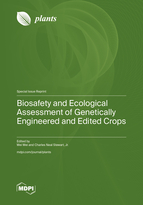Biosafety and Ecological Assessment of Genetically Engineered and Edited Crops
A special issue of Plants (ISSN 2223-7747). This special issue belongs to the section "Crop Physiology and Crop Production".
Deadline for manuscript submissions: closed (20 July 2022) | Viewed by 38387
Special Issue Editors
Interests: climate change adaptation/mitigation; biodiversity conservation practices, strategy and policy; plant adaptation and evolution; plant genetic diversity; plant–insect interaction; ecological consequences of genetically modified organisms derived from modern biotechnology
Interests: biosensors; biotechnology; bioenergy; environmental stress; GFP; phytosensors; plants; promoters; remote sensing; whole organisms; synthetic biology transgenic plants; weedy plants
Special Issues, Collections and Topics in MDPI journals
Special Issue Information
Dear Colleagues,
The journal Plants will be publishing a Special Issue on Biosafety and Ecological Assessment of Genetically Engineered and Edited Crops derived from modern biotechnology. Modern biotechnology and synthetic biology enable genome modification of crop plants. While the majority of these engineered plants have one or two transgene additions, gene editing is a major recent approach to improve crops. Synthetic biology of plants is in its early days but has the potential to make significant genome changes. Engineered crops already cover nearly all popular species used for grain, fruit, oil, vegetables, and forestry, across monocots and dicots, and annual and perennial plants. Although the biosafety of engineered crops has been debated for the past three decades among scientific communities, regulators, and the public, controversy is still strong regarding human health and environmental safety. While food safety remains a critical concern for the general public, the ecological consequences may have long-lasting effects on natural/agricultural ecosystems. Increased scientific understanding and strategies are thus needed to cope with any environmental risks caused by or related to the release of engineered crops, especially regarding new emerging technology, such as synthetic biology and gene drives. This Special Issue will cover a wide range of scientific topics, especially biosafety and ecological assessment studies connected to biodiversity conservation and climate change mitigation.
Dr. Wei Wei
Prof. Dr. Charles Neal Stewart, Jr.
Guest Editors
Manuscript Submission Information
Manuscripts should be submitted online at www.mdpi.com by registering and logging in to this website. Once you are registered, click here to go to the submission form. Manuscripts can be submitted until the deadline. All submissions that pass pre-check are peer-reviewed. Accepted papers will be published continuously in the journal (as soon as accepted) and will be listed together on the special issue website. Research articles, review articles as well as short communications are invited. For planned papers, a title and short abstract (about 100 words) can be sent to the Editorial Office for announcement on this website.
Submitted manuscripts should not have been published previously, nor be under consideration for publication elsewhere (except conference proceedings papers). All manuscripts are thoroughly refereed through a single-blind peer-review process. A guide for authors and other relevant information for submission of manuscripts is available on the Instructions for Authors page. Plants is an international peer-reviewed open access semimonthly journal published by MDPI.
Please visit the Instructions for Authors page before submitting a manuscript. The Article Processing Charge (APC) for publication in this open access journal is 2700 CHF (Swiss Francs). Submitted papers should be well formatted and use good English. Authors may use MDPI's English editing service prior to publication or during author revisions.
Keywords
- ecological consequence
- environmental release
- gene drives
- genome editing
- genetic engineering
- genetically modified
- risk assessment
- synthetic biology








